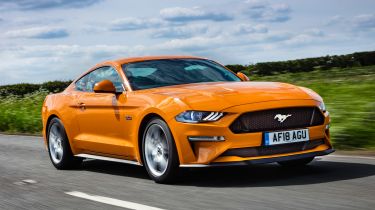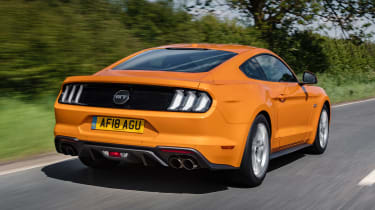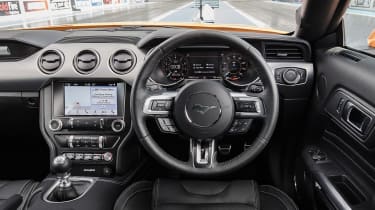Ford Mustang V8 2018 review
We get behind wheel of the muscular Ford Mustang V8 in 2018 facelift form in the UK. Does it live up to the legend?

The Ford Mustang occupies a unique spot in the sports car market. Much more powerful than a Toyota GT86 yet far more affordable than a BMW M4, the Mustang delivers simple rear-wheel drive thrills and a stirring V8 soundtrack. While it lacks the sophistication and build quality of some German rivals, it comes far closer than the huge gulf in price would suggest.
Measure a car’s value for money in terms of brake horsepower per pound and little comes close to the Ford Mustang GT. This is an American icon that, starting from just over £41,000, offers Audi RS 5 power for A5 2.0-litre money.
Yet judging by the wholesale revisions applied to the ‘18 Mustang, driven here for the first time in the UK, it seems that Ford wasn’t satisfied. The 5.0-litre V8 now makes 444bhp - 38bhp more than before; a result of a revised fueling system that mixes both port and direct injection. It’s enough for the new 10-speed auto to cover the 0-62mph dash in just 4.3 seconds, or 4.6 for the manual.
• Best sports cars to buy right now
Curiously, the other engine option has lost power. The 2.3-litre EcoBoost unit improves ‘Eco’ to the detriment of ‘Boost’ - stricter emissions regs enforce changes that deliver a 27bhp drop to 286bhp.
But the 2018 updates don’t end under the bonnet. There are new bumpers front and rear, LED lighting all round (with slimmer headlights) a lower bonnet and quad tailpipes for V8 models. There are also four 19-inch alloy wheel designs to choose from and three new paint colours.
Used - available now

2014 Audi
A1 Sportback
91,000 milesManualDiesel1.6L
Cash £6,450
2017 Ford
Fiesta
76,000 milesManualPetrol1.2L
Cash £4,975
2021 MINI
5-Door Hatch
28,985 milesManualPetrol1.5L
Cash £13,629
2021 MINI
5-Door Hatch
28,407 milesAutomaticPetrol1.5L
Cash £15,134Extra soft touch plastics grace the dash, but the big story inside centres around the tech. An 8-inch touchscreen features Ford’s much-improved Sync 3 system with Android Auto and Apple CarPlay. Most significant is the new 12-inch digital driver’s display in place of the old analogue clocks. It looks great, displaying differing information according to driving mode; there’s a traditional look to Normal, a horizontal rev counter in Track and jazzy “Christmas tree” lighting graphics in the new Drag mode. The latter mixes launch control and the former car’s ‘line lock’ smoky rear tyre warming setup.
There’s tweaks to the suspension too, all of which improve the way the Mustang drives. Uprated shocks, thicker anti-roll bars and a new rear crossmember add control to an extent, but the Mustang still fidgets around town and never quite settles at speed. Go for Ford’s new MagneRide adaptive dampers, however, and bumps are rounded off in a way that, while not quite RS 5 smooth, make the Mustang feel more sophisticated than ever before. Wonderfully supportive front seats help the comfort no end, too.
Appropriately for a muscle car, the steering feels quite heavy on the move, and while not brimming with feel, it’s accurate enough. A well-balanced chassis is just a throttle jab away from a playful one.
Unlike the new suspension tech, we’d steer clear of the 10-speed auto. Though smooth, it’s too lazy to respond - both in kickdown or when using the wheel-mounted paddles. The revised six-speed manual matches the V8’s character perfectly - it’s more precise than before yet maintains a pleasing sturdiness to the shift action.
The pre-facelift Mustang suffered poor Euro NCAP scores because of a lack of safety tech. The 2018 model should improve on its predecessor’s two-star rating thanks to the inclusion of pre-collision assist with pedestrian detection and a lane keeping aid.









